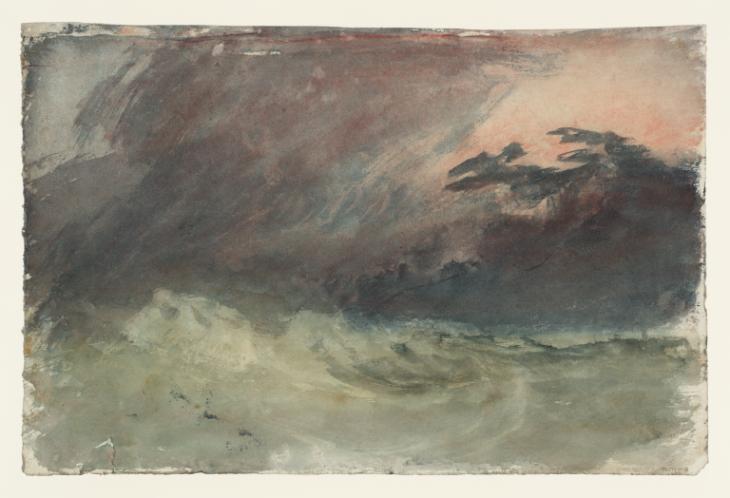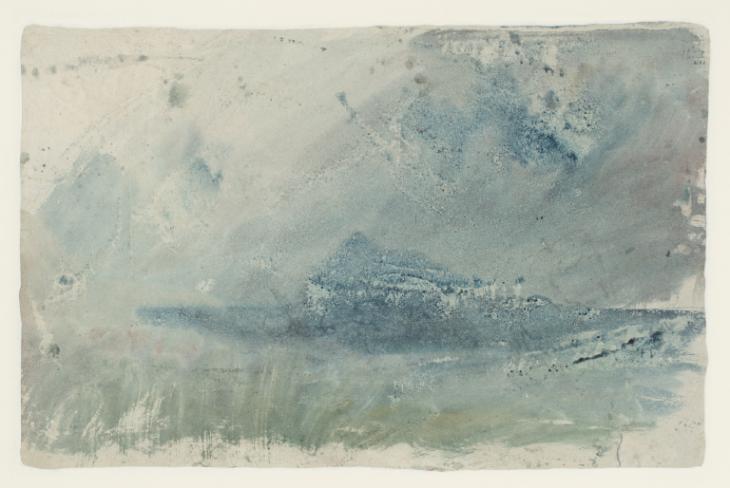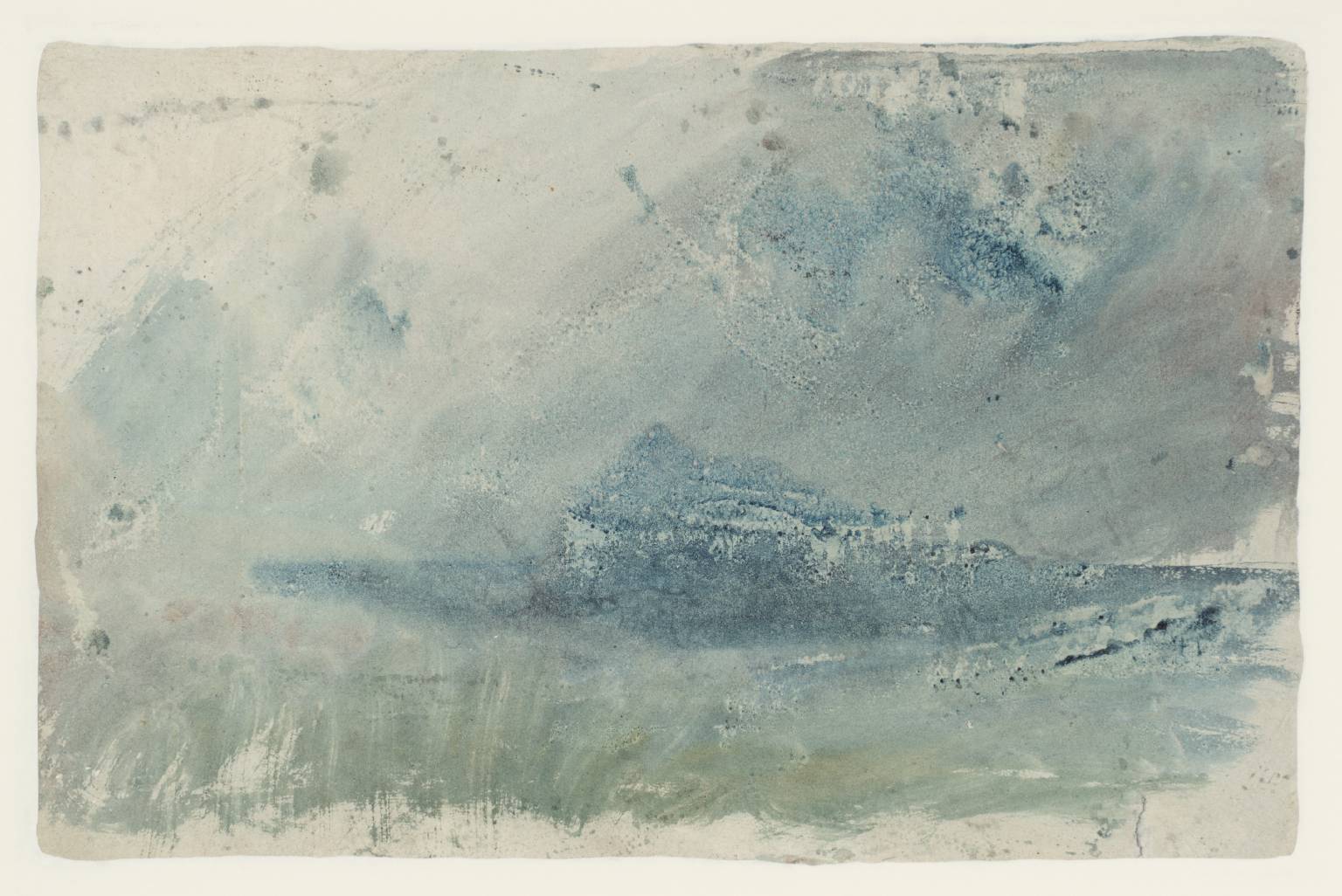Joseph Mallord William Turner 1775–1851
?The Eddystone Lighthouse c.1817
D17172
Turner Bequest CXCVI H
Turner Bequest CXCVI H
Pencil and watercolour on white wove paper, 254 x 383 mm
Blind-stamped with Turner Bequest monogram towards bottom right
Stamped in black ‘CXCVI – H’ bottom right
Blind-stamped with Turner Bequest monogram towards bottom right
Stamped in black ‘CXCVI – H’ bottom right
Accepted by the nation as part of the Turner Bequest 1856
Exhibition history
1937
Aquarelles de Turner, oeuvres de Blake/Englischen Graphiken und Aquarellen: W. Blake und J.M.W. Turner, Bibliothèque Nationale, Paris, January–February 1937, Staatliche Graphische Sammlung Albertina, Vienna, March–April 1937 (95, as ‘Wilde See’).
1989
Summer Miscellany: Watercolours from the Turner Bequest, Tate Gallery, London, July–September 1989 (no catalogue, as ‘A Lighthouse’).
2005
Turner: The Sea, Tate Britain, London, March–October 2005, Tate Liverpool, November 2005–May 2006 (no catalogue, as ‘A Lighthouse. ?Study for “Eddystone Lighthouse”’).
2007
Hockney on Turner Watercolours, Tate Britain, London, June 2007–February 2008 (no number, as ‘?Study for “Eddystone Lighthouse”’, c.1817, reproduced in colour).
2011
William Turner. Maler der Elemente / Turner and the Elements, Bucerius Kunst Forum, Hamburg, June–September 2011, Muzeum Narodowe, Krakow, October–January 2012, Turner Contemporary, Margate, January–May 2012 (31, as ‘?Study for “Eddystone Lighthouse”’, c.1817, reproduced in colour).
2013
Turner from the Tate: The Making of a Master, Art Gallery of South Australia, Adelaide, February–May 2013, National Gallery of Australia, Canberra, June–September (43,as ‘Study for “Eddystone Lighthouse”’, c.1817, reproduced in colour).
2014
Turner from the Tate: The Making of a Master, Tokyo Metropolitan Art Museum, October – December 2013, Kobe City Museum, January–April 2014 (42, as ‘Study for “Eddystone Lighthouse”’, c.1817, reproduced in colour).
References
1820
A.J. Finberg, A Complete Inventory of the Drawings of the Turner Bequest, London 1909, vol.I, p.600, CXCVI H, as ‘A lighthouse’, c.1820.
1817
David Blayney Brown, Turner Watercolours, exhibition catalogue, Tate Britain, London 2007, reproduced in colour p.50, as ‘?Study for “Eddystone Lighthouse”’, c.1817, reproduced in colour.
Finberg described this ‘colour beginning’ as ‘A lighthouse’, tentatively relating it to the large watercolour of about 1817 (private collection)1 engraved in 1824 as The Edystone Light House, ‘Plate I of a Series of Marine Views’ (Tate impression: T04820).2 The lighthouse he noted is no longer readily apparent; possibly it was conveyed by the ‘additions in white chalk’3 he observed, which have presumably faded away or been lost from the surface in the intervening century. Some loose pencil work remains in the rocks and breakers. A pale disk-like area a little above and to the left of centre might correlate with the lighthouse’s beacon or the nearby hidden moon in the finished design. See also Tate D17171 (Turner Bequest CXCVI G), similarly identified by Finberg.
Turner may have visited the Eddystone, about thirteen miles out to sea off Plymouth, Devon, in 1813, as discussed in the entry for Tate D10258 (Turner Bequest CXXXVII 40) in the Vale of Heathfield sketchbook, one of three watercolour studies there of the structure in a stormy setting much as depicted in the 1817 design (see also Tate D10257, D10260; Turner Bequest CXXXVII 39, 41). It is perhaps telling that a fourth page, Tate D10256 (Turner Bequest CXXXVII 38), shows the sea and sky without the lighthouse, as here (at least in the sheet’s present state). This ‘Hamlet without the prince’ approach is not unusual in those of Turner’s colour studies relatable to finished designs which focus on establishing light and mood; compare the colour study for Stonehenge in the Picturesque Views in England and Wales (Tate D25123; Turner Bequest CCLXIII 1).
Verso:
Not inscribed. Not mentioned in Finberg’s 1909 Inventory,1 this side has been extensively worked with heavily mottled blue washes, evoking a marine horizon with the silhouette of a distant pyramidal rock. This might be a variant of the Eddystone theme, or perhaps relates to the Mewstone, a prominent coastal feature near Plymouth; for a detailed discussion of the subject, see the entry for the mid-1820s colour study for Turner’s ‘Little Liber’ (Tate D17170; Turner Bequest CXCVI F).
Matthew Imms
July 2016
How to cite
Matthew Imms, ‘?The Eddystone Lighthouse c.1817 by Joseph Mallord William Turner’, catalogue entry, July 2016, in David Blayney Brown (ed.), J.M.W. Turner: Sketchbooks, Drawings and Watercolours, Tate Research Publication, February 2017, https://www



